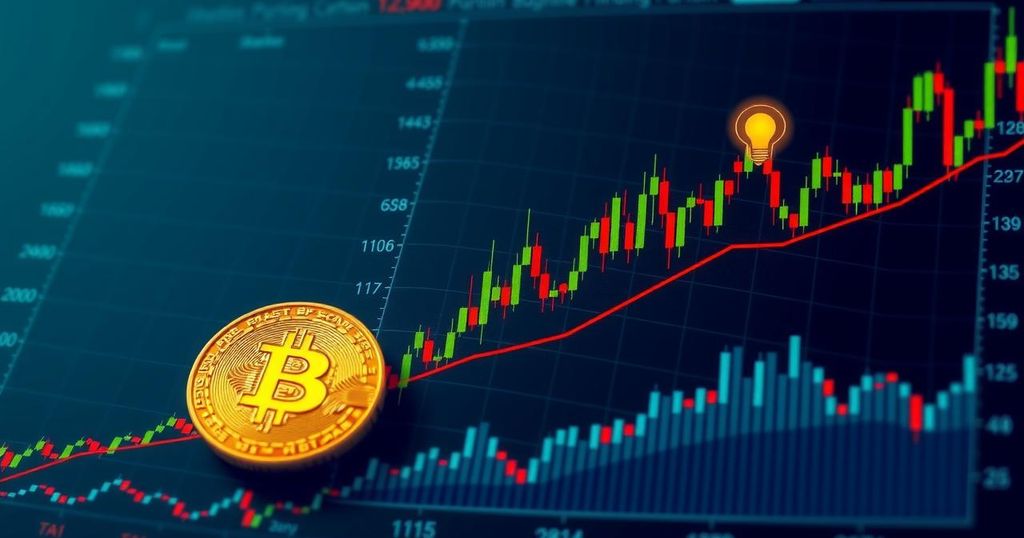Understanding the MOVE Index and Its Implications for Bitcoin Price Movements
An examination of the MOVE Index reveals it may forecast certain price movements of Bitcoin due to an observed inverse relationship. Developed by Merrill Lynch, the MOVE Index measures volatility in the U.S. bond market and reflects investor sentiment. Historical analyses indicate that price trends in Bitcoin often react inversely to movements in the MOVE Index, although these correlations are not fixed or entirely reliable, highlighting the complexities of financial behaviors across different markets.
There exists an intriguing index, known as the MOVE Index, which may possess the capability to predict certain price movements of Bitcoin (BTC) with a degree of foresight. This index shows a historical inverse correlation with Bitcoin’s price fluctuations; however, the relationship lacks a definitive underlying mechanism. Rather, it is based merely on the observation that movements in the index have often been followed by opposing movements in Bitcoin prices after a brief interval. For instance, this phenomenon was also noted during the recent week. The MOVE Index stands for the U.S. Bond Market Option Volatility Estimate Index and primarily gauges the daily volatility within the American bond market. Originally conceived by Merrill Lynch to measure levels of apprehension in this market, the MOVE index was rebranded in 2019 to reflect its affiliation with ICE and still retains the MOVE acronym. This index specifically assesses the volatility associated with options traded on U.S. Treasury Bonds and serves as a parameter for tracking risk perception among investors. It operates by monitoring the implied volatility across various durations of U.S. Treasury returns, ranging from 2 to 30 years. The utility of the MOVE Index lies in its ability to provide insights into market sentiment regarding risk and insurance against market ups and downs. A decreasing MOVE Index suggests declining fear and, thus, lower demand for risk protection among investors. The index typically fluctuates between 80 and 120, with values below 80 indicating minimal fear and those above 120 indicating extreme fear among market participants. A noteworthy aspect of the MOVE Index is its apparent inverse correlation with Bitcoin prices, which was initially uncovered by Vito Lops, a journalist for Sole 24 Ore. Given that the MOVE Index is determined once daily at the closure of stock market activity, it allows for analysis of daily price charts. Historical data indicates that between 2017 and 2019, as the MOVE Index fell significantly, Bitcoin experienced substantial price gains, whereas subsequent rises in the MOVE Index coincided with Bitcoin’s bear market phases. Furthermore, there is an observable trend where movements in the MOVE Index often precede corresponding price shifts in Bitcoin. For example, recent fluctuations demonstrated that an uptick in the MOVE Index accompanied a decline in Bitcoin’s price, followed by a temporary stoppage of that decline as the MOVE Index began to decrease again. This behavior has been similarly recorded during other intervals, suggesting a potential predictive capability of the MOVE Index regarding Bitcoin’s pricing trends, albeit with the caveat that such correlations are neither absolute nor consistently reliable. Understanding the nuances and the limitations of the MOVE Index in predicting Bitcoin price movements is crucial for investors and market observers. It underscores the complex dynamics between traditional financial indicators and emerging digital assets.
The MOVE Index is an important financial benchmark particularly associated with the volatility of options on U.S. Treasury bonds. Its historical significance arises from its potential correlation with cryptocurrency markets, specifically Bitcoin, which has captured the attention of traders and analysts alike. The recognition of this index’s volatility in relation to Bitcoin signals a new depth in the analysis of price movements across different financial markets. Given the transformative nature of cryptocurrencies, understanding tools like the MOVE Index provides insights into their behavior and investor sentiment.
In conclusion, the MOVE Index serves as a valuable tool for anticipating potential shifts in Bitcoin’s price through its historical inverse correlation with market movements. While not a definitive predictor, its insights regarding fluctuations in investor sentiment can offer additional context for traders. Caution must be exercised in interpreting its signals due to the lack of consistent reliability in this correlation. Therefore, the utilization of the MOVE Index alongside other financial analyses may enhance the understanding of the complex relationship between traditional and digital financial markets.
Original Source: en.cryptonomist.ch






Post Comment